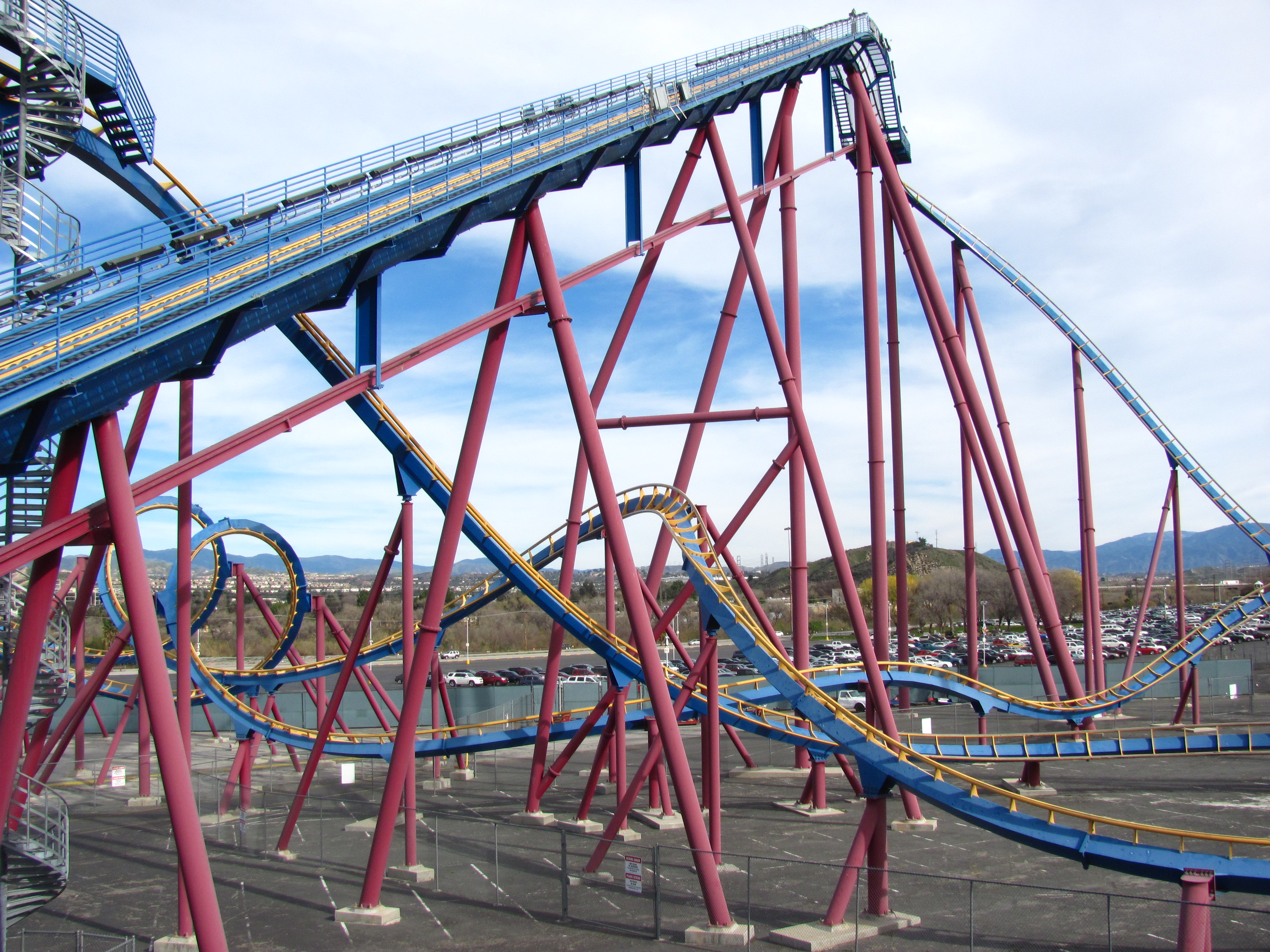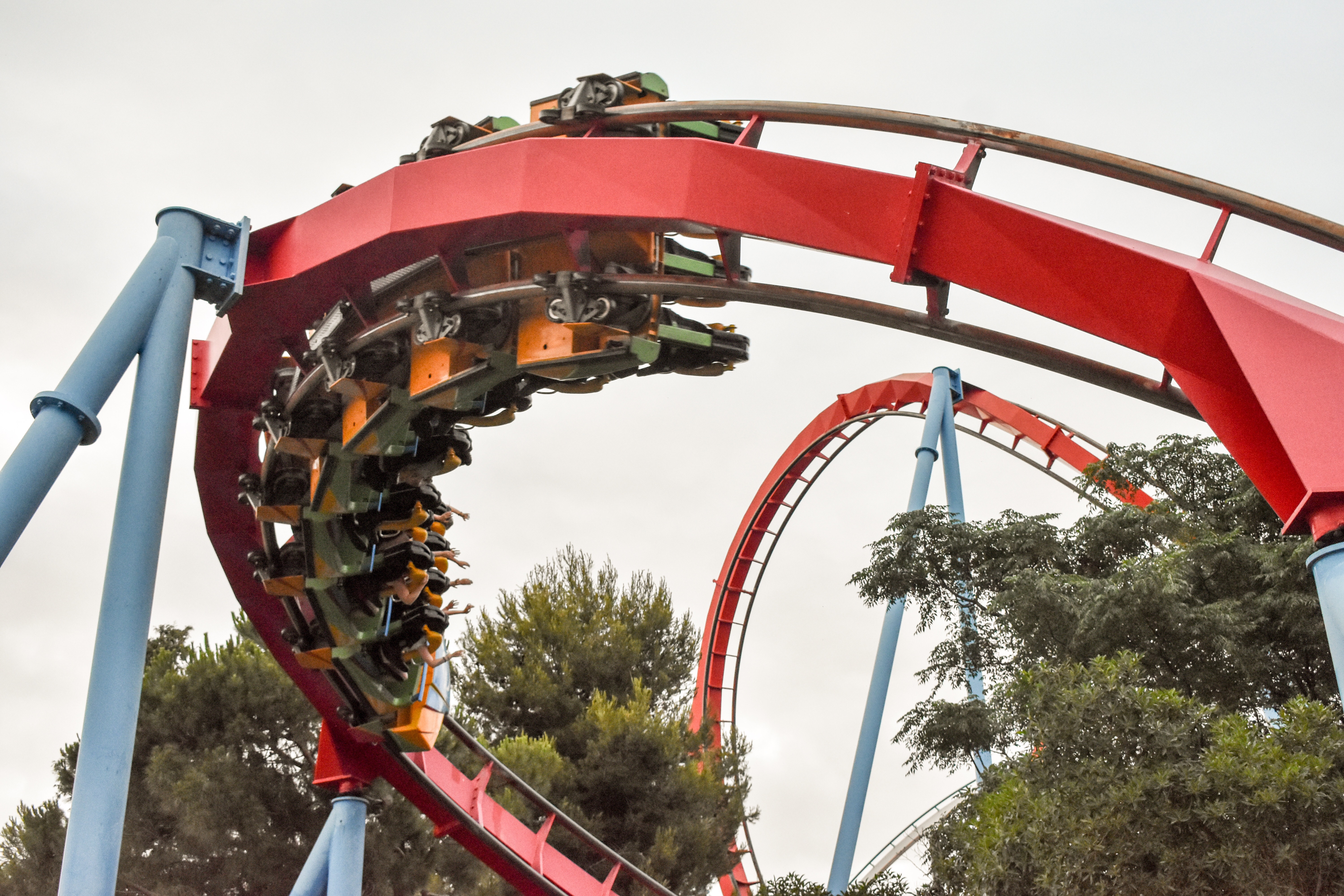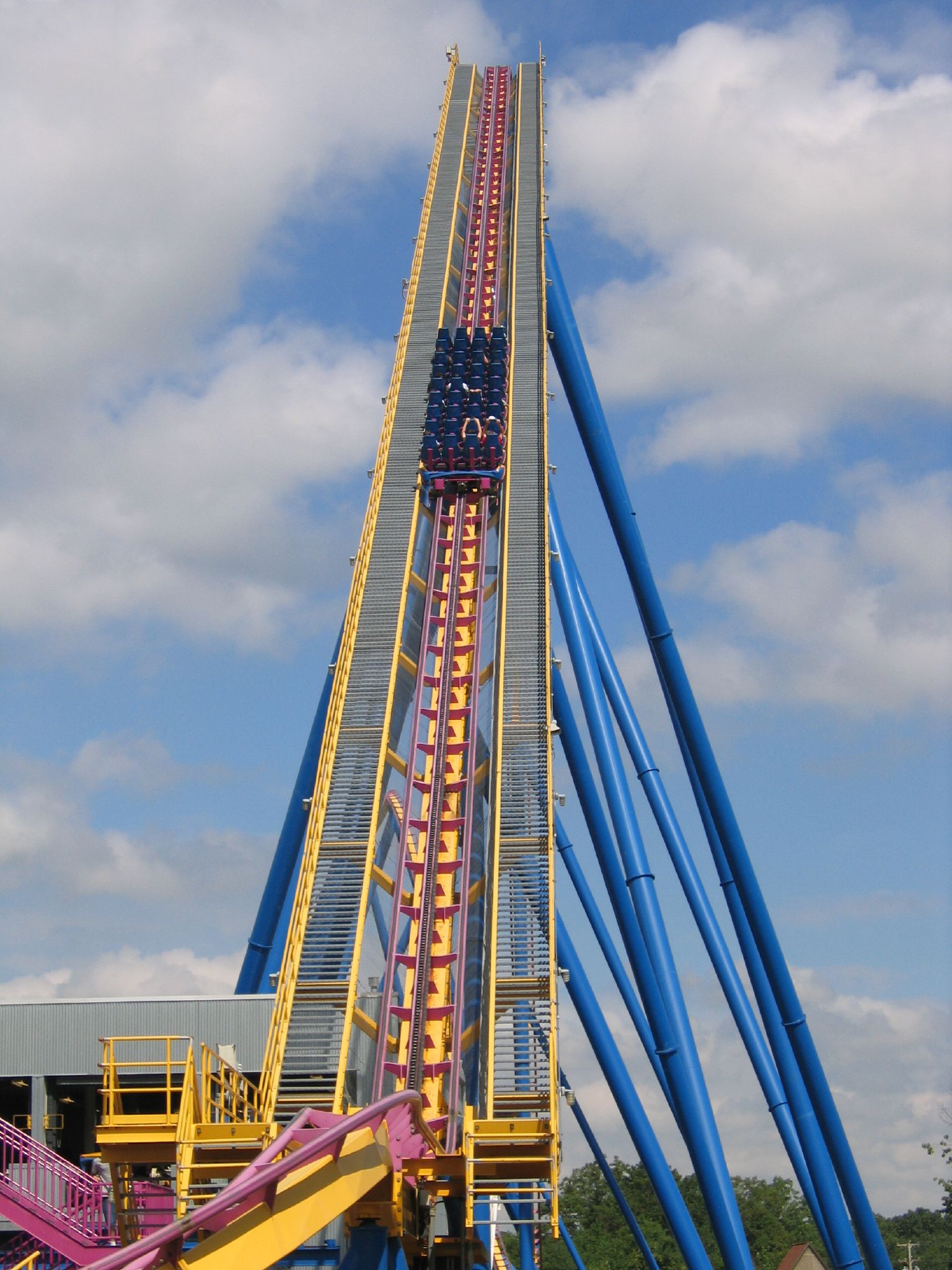|
Scream (roller Coaster)
Scream (originally stylised as Scream!) is a steel roller coaster at Six Flags Magic Mountain. Manufactured by Bolliger & Mabillard, the Floorless Coaster model was the park's sixteenth roller coaster and is located in the Screampunk District area of the park. The ride consists of a series of roller coaster elements including seven inversions ranging from a zero-g roll to interlocking corkscrews. The ride is a mirror image of Medusa at Six Flags Great Adventure. History In 1999, Six Flags Great Adventure spent $42 million on new attractions including a prototype Floorless Coaster, Medusa, developed and built by Bolliger & Mabillard. The immediate popularity of the ride led to several parks installing Floorless Coasters in the early 2000s. In November 2002, parts for Scream began arriving at Six Flags Magic Mountain. On November 14, 2002, the park officially announced that they would be adding Scream for the 2003 season, making it the park's sixteenth roller coaster. According ... [...More Info...] [...Related Items...] OR: [Wikipedia] [Google] [Baidu] |
Werner Stengel
Werner Stengel (born 22 August 1936, in Bochum) is a German roller coaster designer and engineer. Stengel is the founder of Stengel Engineering, also known as Ingenieurbüro Stengel GmbH (or Ingenieurbuero Stengel GmbH). Stengel first worked on amusement park rides in collaboration with Anton Schwarzkopf in 1963. He established his own company, Stengel Engineering, in 1965. His collaboration with Schwarzkopf was responsible for many innovations in roller coaster design, including in 1976 the first modern "vertical" looping coaster, ''Revolution'', at Six Flags Magic Mountain. (Arrow Dynamics had debuted the first modern inversion, the corkscrew, a year earlier at Knott's Berry Farm). His clothoid loop is now standard on many roller coasters, as it produces less intense forces on the human body than a circular vertical loop. In 1976 Stengel and Schwarzkopf established the first horizontal launch "Shuttle Loop". He was a pioneer in heartlining, the principle of having the track twis ... [...More Info...] [...Related Items...] OR: [Wikipedia] [Google] [Baidu] |
Dive Loop
Roller coaster elements are the individual parts of roller coaster design and operation, such as a track, hill, loop, or turn. Variations in normal track movement that add thrill or excitement to the ride are often called "thrill elements". Common elements Banked turn A banked turn is when the track twists from the horizontal plane into the vertical plane, tipping the train to the side in the direction of the turn. Banking is used to minimize the lateral G-forces on the riders to make the turn more comfortable. When a banked turn continues to create an upward or downward spiral of approximately 360 degrees or more, it becomes a helix. Brake run A brake run on a roller coaster is any section of track meant to slow or stop a roller coaster train. Brake runs may be located anywhere or hidden along the circuit of a coaster and may be designed to bring the train to a complete halt or to simply adjust the train's speed. The vast majority of roller coasters do not have any form of bra ... [...More Info...] [...Related Items...] OR: [Wikipedia] [Google] [Baidu] |
Deseret News
The ''Deseret News'' () is the oldest continuously operating publication in the American west. Its multi-platform products feature journalism and commentary across the fields of politics, culture, family life, faith, sports, and entertainment. The ''Deseret News'' is based in Salt Lake City, Utah and is published by Deseret News Publishing Company, a subsidiary of Deseret Management Corporation, which is owned by the Church of Jesus Christ of Latter-day Saints. The publication's name is from the geographic area of Deseret identified by Utah's pioneer settlers, and much of the publication's reporting is rooted in that region. On January 1, 2021, the newspaper switched from a daily to a weekly print format while continuing to publish daily on the website and Deseret News app. As of 2022, ''Deseret News'' develops daily content for its website and apps in addition to weekly print editions of the Deseret News Local Edition and the Church News. Deseret News publishes 10 editions of Des ... [...More Info...] [...Related Items...] OR: [Wikipedia] [Google] [Baidu] |
New York Times Company
The New York Times Company is an American mass media company that publishes ''The New York Times''. Its headquarters are in Manhattan, New York City. History The company was founded by Henry Jarvis Raymond and George Jones in New York City. The first edition of the newspaper ''The New York Times'', published on September 18, 1851, stated: "We publish today the first issue of the New-York Daily Times, and we intend to issue it every morning (Sundays excepted) for an indefinite number of years to come." The company moved into the cable channel industry, purchasing a 40% interest in the Popcorn Channel, a theatrical movie preview and local movie times, in November 1994. In 1996, it expanded upon its broadcasting by purchasing Palmer Communications, owners of WHO-DT in Des Moines and KFOR in Oklahoma City. The company completed its purchase of ''The Washington Post'' 50 percent interest in the ''International Herald Tribune'' (''IHT'') for US$65 million on January 1, 2003, becom ... [...More Info...] [...Related Items...] OR: [Wikipedia] [Google] [Baidu] |
About '', one of the future constructions in English grammar
*
{{disambiguation ...
About may refer to: * About (surname) * About.com, an online source for original information and advice * about.me, a personal web hosting service * ''abOUT'', a Canadian LGBT online magazine * ''About Magazine'', a Texas-based digital platform covering LGBT news * About URI scheme, an internal URI scheme * About box, a dialog box that displays information related to a computer software * About equal sign, symbol used to indicate values are approximately equal See also * About Face (other) * About Last Night (other) * About Time (other) * About us (other) * About You (other) * ''about to The ''going-to'' future is a grammatical construction used in English to refer to various types of future occurrences. It is made using appropriate forms of the expression ''to be going to''.Fleischman, Suzanne, ''The Future in Thought and Langua ... [...More Info...] [...Related Items...] OR: [Wikipedia] [Google] [Baidu] |
Scream Lift Hill
Scream may refer to: *Screaming, a loud vocalization Amusement rides * Scream (Heide Park), a gyro drop tower in Soltau, Germany * Scream! (ride), a tower ride at Six Flags Fiesta Texas and Six Flags New England * Scream! (roller coaster), at Six Flags Magic Mountain in California Arts, entertainment, and media Fictional characters * Scream (comics), a fictional character in the ''Spider-Man'' comic book series * Angar the Screamer or Scream, a fictional character in the Marvel Comics universe Films and television * ''Scream'', a 1964 Greek noir film directed by Kostas Andritsos * ''Scream'' (1981 film), a slasher film * ''Scream'' (franchise), a series of American horror films ** ''Scream'' (1996 film), the first of the series of horror films ** ''Scream'' (TV series), a 2015 television adaptation of the film franchise ** ''Scream'' (2022 film), the fifth installment of the film series * Scream (TV channel), a Canadian cable TV channel (2001-2009) Music Albums * ''S ... [...More Info...] [...Related Items...] OR: [Wikipedia] [Google] [Baidu] |
Brake Run
A brake run on a roller coaster is any section of track meant to slow or stop a roller coaster train. Brake runs may be located anywhere along the circuit of a coaster and may be designed to bring the train to a complete halt or to simply adjust the train's speed. Contrary to some belief, the vast majority of roller coasters do not have any form of braking on the train itself, but rather forms of braking that exist on track sections. One notable exception is the Scenic Railway roller coaster, which relies on an operator to manually control the speed of the train. On most roller coasters, the brakes are controlled by a computer system. Some older coasters have manually operated friction or skid brakes, some with a pneumatic assist. These are either engaged at the control panel or operated by pulling or pushing large levers in the station. Trim brakes Trim brakes are sections of brakes which are intended to adjust a train's speed during its course rather than bring the train to ... [...More Info...] [...Related Items...] OR: [Wikipedia] [Google] [Baidu] |
Mid-course Brake Run
A brake run on a roller coaster is any section of track meant to slow or stop a roller coaster train. Brake runs may be located anywhere along the circuit of a coaster and may be designed to bring the train to a complete halt or to simply adjust the train's speed. Contrary to some belief, the vast majority of roller coasters do not have any form of braking on the train itself, but rather forms of braking that exist on track sections. One notable exception is the Scenic Railway roller coaster, which relies on an operator to manually control the speed of the train. On most roller coasters, the brakes are controlled by a computer system. Some older coasters have manually operated friction or skid brakes, some with a pneumatic assist. These are either engaged at the control panel or operated by pulling or pushing large levers in the station. Trim brakes Trim brakes are sections of brakes which are intended to adjust a train's speed during its course rather than bring the train to a ... [...More Info...] [...Related Items...] OR: [Wikipedia] [Google] [Baidu] |
Air-time
In the context of amusement rides, air time, or airtime, refers to the time during which riders of a roller coaster or other ride experience either frictionless or negative G-forces. The negative g-forces that a rider experiences is what creates the sensation the rider feels of floating out of their seat. With roller coasters, air time is usually achieved when the train travels over a hill at speed. There are different sensations a rider will feel depending on the ride being an ejector or floater airtime ride. In 2001 the Guinness World Records recorded Superman: Escape from Krypton, located at Six Flags Magic Mountain, Valencia, California, one of the fastest roller coaster in the world, where riders experienced a then record 6.5 seconds of 'airtime' or negative G-force.Guinness World Records 2001- Page 86 "Superman The Escape, located at Six Flags Magic Mountain, Valencia, California, USA, is the fastest roller coaster in the world. They experience a record 6.5 seconds of ' ... [...More Info...] [...Related Items...] OR: [Wikipedia] [Google] [Baidu] |
Chain Lift Hill
A lift hill, or chain hill, is an upward-sloping section of track on a roller coaster on which the roller coaster train is mechanically lifted to an elevated point or peak in the track. Upon reaching the peak, the train is then propelled from the peak by gravity and is usually allowed to coast throughout the rest of the roller coaster ride's circuit on its own momentum, including most or all of the remaining uphill sections. The initial upward-sloping section of a roller coaster track is usually a lift hill, as the train typically begins a ride with little speed, though some coasters have raised stations that permit an initial drop without a lift hill. Although uncommon, some tracks also contain multiple lift hills. Lift hills usually propel the train to the top of the ride via one of two methods: a chain lift involving a long, continuous chain which trains hook on to and are carried to the top; or a drive tire system in which multiple motorized tires (known as friction wheels) ... [...More Info...] [...Related Items...] OR: [Wikipedia] [Google] [Baidu] |
Station (roller Coaster)
Roller coaster elements are the individual parts of roller coaster design and operation, such as a track, hill, loop, or turn. Variations in normal track movement that add thrill or excitement to the ride are often called "thrill elements". Common elements Banked turn A banked turn is when the track twists from the horizontal plane into the vertical plane, tipping the train to the side in the direction of the turn. Banking is used to minimize the lateral G-forces on the riders to make the turn more comfortable. When a banked turn continues to create an upward or downward spiral of approximately 360 degrees or more, it becomes a helix. Brake run A brake run on a roller coaster is any section of track meant to slow or stop a roller coaster train. Brake runs may be located anywhere or hidden along the circuit of a coaster and may be designed to bring the train to a complete halt or to simply adjust the train's speed. The vast majority of roller coasters do not have any form of bra ... [...More Info...] [...Related Items...] OR: [Wikipedia] [Google] [Baidu] |



.png)
